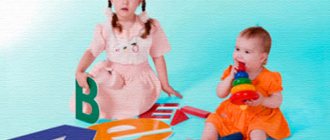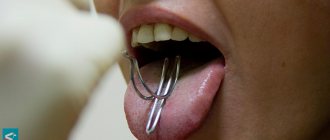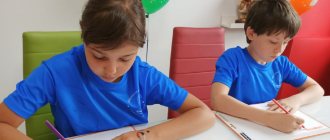Disorders of language acquisition
The psychological and pedagogical classification determines the content and conditions for the implementation of the educational program, which can be mastered by a child with normal physical hearing and intact intelligence, starting from the age of 4. Types of speech disorders, according to this approach, are described in accordance with how the child masters and uses the language system - its phonetic, lexical and grammatical means - in oral and written speech.
Disturbances in the development of the language system manifest themselves in different ways.
Phonetic-phonemic underdevelopment (FFN)
is expressed in a violation of pronunciation (distortion, confusion, substitution, absence of sound) and perception, discrimination of speech sounds.
Phonetic disorder (PHI)
is expressed only in the distorted pronunciation of sounds while their perception and discrimination are intact.
General speech underdevelopment (GSD)
is defined as the immaturity of all components of the language system in children with normal hearing and initially intact intelligence. This disorder manifests itself both in the child’s own speech and in the process of understanding speech addressed to him. It affects pronunciation and recognition of sounds, vocabulary, grammatical formatting of statements, and text construction.
Three levels of speech development
First level
- “babbling speech”, consisting of onomatopoeia, amorphous words, and sound complexes. Speech is incomprehensible to others and is often replaced by paralinguistic means of communication - gestures, facial expressions. It is difficult for a child to understand spoken speech.
Second
- the beginnings of commonly used phrasal speech. At the same time, the phonetic and grammatical design of the phrase is distorted. The child uses words denoting individual objects, actions and signs, and also notes attempts at inflection and word formation. However, these attempts are most often unsuccessful, as is the reproduction of the syllabic structure of words. Pronunciation and perception of speech sounds are impaired. Addressed speech is generally perceived undifferentiated.
Third
- elementary detailed speech with errors in the use of language units at all levels.
Fourth
- residual manifestations of speech underdevelopment, affecting individual components of the language system and manifesting itself, first of all, in complex forms of speech activity.
With mental retardation, intellectual impairment, and hearing loss, an outwardly similar state of linguistic means may be detected; in these cases, the term “systemic speech underdevelopment” is used, which allows us to delimit the nature of the disorder.
The psychological and pedagogical approach allows us to build a system of teaching children with similar speech disorders. It is these conclusions that are formulated by the speech therapist and used by the psychological, medical and pedagogical commission when developing the child’s educational route.
However, to determine the causes and mechanisms of speech disorders, to build individualized schemes of correctional work and predict its results, speech therapists and doctors use a clinical and pedagogical classification, according to which violations of oral speech (its external or internal, semantic-semantic, design) and written speech are distinguished.
Correction methods
Timely correction of speech impairment can be a way to get rid of the diagnosed problem. As a rule, it is recommended to perform it at an early age with the assistance of experienced speech therapists. Depending on what characteristic of the speech disorder is identified, the following may be involved:
- activation of impressive/expressive speech activity;
- development of general and fine motor skills;
- emphasis on intensifying auditory or visual perception;
- formation of prosody;
- development of articulatory motor skills.
Even severe speech disorders can be corrected if special techniques are used in combination with high intensity training (8-10 hours daily). To help patients, special tools may also be provided to simplify the process of communicating with others. For example, a communicator for people with speech impairments.
The article is for informational purposes only, self-medication is not acceptable. Be sure to consult with your healthcare provider.
Violations of the external design of oral speech
Dysphonia
(aphonia) - a violation (absence) of the voice, its strength, pitch and timbre, due to organic or functional reasons and may be part of other disorders.
Impaired speech rate - bradyllia
(pathologically slow rate) and tachylalia (pathologically accelerated rate of speech).
Stuttering
- a violation of the tempo-rhythmic organization of speech, caused by the convulsive state of the muscles of the speech apparatus.
Dislalia
— violation of sound pronunciation with normal hearing and intact innervation of the speech apparatus; manifests itself in distorted pronunciation of sounds, their replacement and/or mixing.
Rhinolalia
— disturbances in voice timbre and sound pronunciation caused by anatomical and physiological defects of the speech apparatus (congenital cleft palate); manifests itself in a change in the timbre of the voice, which turns out to be excessively nasal (“nasal”) due to the fact that a stream of air passes during the pronunciation of all speech sounds into the nasal cavity and receives resonance in it.
Dysarthria
— violation of the pronunciation aspect of speech (sound pronunciation, voice, speech melody), caused by insufficient innervation of the speech apparatus; can manifest itself to varying degrees from a complete inability to reproduce speech sounds (anarthria) to individual pronunciation disorders (minimal, “erased” degree).
Main types of speech disorders
Dyslalia - disorder of sound pronunciation
With dyslalia, hearing and innervation of the muscles of the speech apparatus remain intact.
Impaired sound pronunciation in dyslalia is associated with an anomaly in the structure of the articulatory apparatus or features of speech education. In this regard, a distinction is made between mechanical and functional dyslalia. Mechanical (organic) dyslalia is associated with a violation of the structure of the articulatory apparatus: malocclusion, incorrect structure of teeth, abnormal structure of the hard palate, abnormally large or small tongue, short frenulum of the tongue; these defects make it difficult to pronounce normal speech sounds. Functional dyslalia is most often associated with:
- with improper speech education of the child in the family (“lisping”, using “nanny language” when adults communicate with the child);
- incorrect sound pronunciation of adults in the child’s immediate environment;
- pedagogical neglect, immaturity of phonemic perception.
Often, functional dyslalia is observed in children who, in early preschool age, master two languages at once, and a shift in the speech sounds of two language systems may be observed.
A child with dyslalia may have a problem with the pronunciation of one or more sounds that are difficult to articulate (whistling, hissing, r, l). Violations of sound pronunciation can manifest themselves in the absence of certain sounds, distortion of sounds or their replacement.
In speech therapy practice, violations of the pronunciation of sounds have the following names:
- sigmatism (lack of pronunciation of whistling and hissing sounds);
— rhotacism (lack of pronunciation of sounds р-р');
- lambdacism (lack of pronunciation of sounds l-l');
- defects in the pronunciation of palatal sounds (lack of pronunciation of the sounds k-k', g-g', x-x', th);
- defects in voicing (instead of voiced sounds, their unvoiced pairs are pronounced);
- softening defects (instead of hard sounds, soft pairs are pronounced).
Children with dyslalia, as a rule, do not have speech development disorders, i.e., the lexical and grammatical aspects of speech are formed in accordance with the norm.
It is known that the formation of normative sound pronunciation in children occurs gradually until the age of four. If a child after four years of age has defects in sound pronunciation, it is necessary to contact a speech therapist. However, special work on the development of the sound-pronunciation side of speech in case of its violation can begin earlier.
Voice disorders
Voice disorder is the absence or disorder of voice formation (phonation) due to pathological changes in the vocal apparatus.
A distinction is made between partial voice impairment (the pitch, strength and timbre suffer) - dysphonia and complete absence of voice - aphonia. Voice disorders that arise as a result of chronic inflammatory processes of the vocal apparatus or its anatomical changes are classified as organic . These are dysphonia and aphonia in chronic laryngitis, paralysis of the laryngeal muscles, tumors and conditions after surgical interventions on the larynx and soft palate.
Functional voice disorders also manifest themselves in aphonia and dysphonia. They are more common and more diverse. These disorders are associated with vocal fatigue, various infectious diseases, as well as traumatic situations. The voice of a person suffering from dysphonia is perceived by the listener as hoarse, hoarse, dry, exhausted, with a small range of vocal modulations.
Voice disorders occur in both adults and children. Age-related changes in voice occur in adolescents aged 13-15 years, which is associated with endocrine changes during puberty. This period of voice development is called mutational. At this time, the teenager needs a protective voice mode. You can’t overstrain or force your voice. Persons whose profession involves prolonged vocal stress are recommended to have a special positioning of their speech voice, which protects it from overstrain.
Rhinolalia
Rhinolalia is a violation of sound pronunciation and voice timbre associated with a congenital anatomical defect in the structure of the articulatory apparatus.
The anatomical defect manifests itself in the form of a cleft (cleft) on the upper lip, gum, hard and soft palate. As a result, between the nasal and oral cavities there is an open cleft (hole) or a cleft covered by a thinned mucous membrane. Often clefts are combined with various dental anomalies.
The speech of a child with rhinolalia is characterized by slurring due to the nasality (nasality) of the voice and impaired pronunciation of many sounds. The wider the cleft, the stronger its negative impact on the formation of the sound side of speech. In severe cases, the child’s speech is not understandable to others. Disturbances in the structure and activity of the speech apparatus in rhinolalia cause deviations in the development of not only the sound side of speech. All structural components of the language system suffer to varying degrees.
Children suffering from rhinolalia need early medical examination, orthodontic and surgical treatment. Speech therapy assistance for such children is necessary both in the pre- and postoperative period. It must be systematic and long enough.
Dysarthria
Dysarthria is a violation of the sound-pronunciation and melodic-intonation aspects of speech, caused by insufficient innervation of the muscles of the speech apparatus.
Dysarthria is associated with organic damage to the nervous system, as a result of which the motor side of speech is impaired. This disorder can occur in both children and adults. The cause of dysarthria in childhood is damage to the nervous system, mainly in the prenatal or childbirth period, often against the background of cerebral palsy. Cerebral palsy (CP) includes a large group of motor disorders that develop with organic damage to the motor systems of the brain.
Such children have a lag in motor development, disturbances of voluntary movements, and dysontogenesis in the formation of motor skills. Motor disturbances can be expressed to varying degrees: from paralysis of the arms and legs to minor deviations in the movement of the organs of articulation. Such children begin to sit, stand, walk, and talk later than their healthy peers.
With dysarthria, disorders of sound pronunciation, voice formation, tempo-rhythm of speech and intonation are observed. The degree of severity of dysarthria varies: from the complete inability to pronounce speech sounds (anarthria) to the vagueness of pronunciation barely noticeable to the listener (erased dysarthria), which depends on the nature and severity of damage to the nervous system.
There are several clinical forms of dysarthria, the nature of which is associated with the location of organic damage to the nervous system. In childhood, mixed forms of dysarthria, expressed in mild to moderate degrees, are most common. As a rule, with dysarthria, children's speech develops with a delay. Such children often suffer from pronunciation of sounds that are difficult to articulate (s-s', z-z', c, sh, sch, zh, ch, r-r', l-l'). In general, the pronunciation of sounds is unclear, blurred (“porridge in the mouth”). The voice of such children may be weak, hoarse, and nasal.
Speech is low-intonation, inexpressive. The pace of speech can be either accelerated or slow. The phonemic perception of such children, as a rule, is not sufficiently formed. Sound analysis and synthesis are difficult to carry out. The lexical and grammatical side of speech usually does not suffer severely, at the same time, almost all children with dysarthria have a poor vocabulary and insufficient command of grammar and constructions.
The process of mastering writing and reading for such children is difficult. Handwriting is uneven, letters are disproportionate, children have great difficulty mastering cursive writing, and persistent specific writing errors (dysgraphia) are observed. Reading aloud in such children is uncolored, reading speed is reduced, and understanding of the text is limited. They make a large number of reading errors (dyslexia). Children suffering from dysarthria need early speech therapy and long-term correction of speech defects.
Stuttering
Stuttering is a disturbance in the fluency of speech caused by muscle spasms of the speech apparatus.
Stuttering usually begins in children between the ages of 2 and 6 years. It can appear in children with advanced speech development as a result of excessive speech load, mental trauma, or in children with delayed speech development as a result of damage to certain structures of the central nervous system.
The main manifestation of stuttering is muscle spasms of the speech apparatus, which occur only at the moment of speaking or when trying to start speaking. The speech of people who stutter is characterized by repetitions of sounds, syllables or words, prolongation of sounds, breaking of words, insertion of additional sounds or words. In addition to speech spasms, people who stutter exhibit a number of characteristics.
The convulsive speech of people who stutter is, as a rule, accompanied by accompanying movements: closing their eyes, flaring the wings of the nose, nodding movements of the head, stamping their feet, etc. People who stutter often use in their speech insert words that are repeated in a variety of ways throughout the entire utterance, such as: here, this, well etc. The use of such words by people who stutter is obsessive.
At the age of 10-12, teenagers who stutter often become aware of their speech defect, and in connection with this, they fear making an unfavorable impression on their interlocutor, drawing the attention of strangers to their speech defect, or being unable to express a thought due to convulsive stuttering. At this age, people who stutter begin to develop a persistent fear of verbal communication with an obsessive expectation of speech failures - logophobia. An emotional reaction in the form of logophobia increases speech hesitations during communication.
Logophobia, as a rule, manifests itself especially clearly in certain situations: talking on the phone, answering at the blackboard, when communicating in a store, etc. In connection with this, a reaction of avoiding such situations and limiting verbal communication appear. Often, logophobia in teenagers leads to a refusal to answer orally in front of the class; teenagers ask teachers to question them either in writing or after class. At the same time, when communicating during recess, with close friends, or at home with relatives, people who stutter can speak quite smoothly and freely.
Despite the speech and psychological difficulties that such adolescents experience, the teacher should not replace the oral responses of stutterers with written ones. Due to the fact that coherent contextual speech is actively formed during schooling, transferring a stuttering teenager to a written form of speech has a negative impact on the formation of a monologue utterance as a whole. In addition, the lack of speech practice in the context of educational activities negatively affects all aspects of oral speech, and most importantly, verbal communication. To overcome a speech defect, a person who stutters requires systematic help from a speech therapist, and in cases where stuttering is protracted (adolescents, adults), also the help of a psychologist.
Alalia
Alalia is the absence or underdevelopment of speech in children caused by organic brain damage.
Alalia is one of the most severe and complex speech defects. This speech pathology is characterized by a late appearance of speech, its slow development, and a significant limitation of both passive and active vocabulary. Speech development in this disorder follows a pathological path. Depending on the predominant symptoms, there are mainly two forms of alalia: expressive and impressive.
With expressive (motor) alalia, the sound image of the word is not formed. The oral speech of such children is characterized by simplifications of the syllabic structure of words, omissions, rearrangements and replacements of sounds, syllables, as well as words in a phrase. The acquisition of grammatical structures of the language suffers significantly. The speech development of such children varies: from a complete absence of oral speech to the ability to express fairly coherent statements, in which various errors can be observed. In accordance with this, the degree of compensation for a speech defect as a result of speech therapy may vary. These children understand everyday speech quite well and respond adequately to adults addressing them, but only within the framework of a specific situation.
Impressive (sensory) alalia is characterized by a violation of the perception and understanding of speech with full physical hearing. The leading symptom of this disorder is a disorder of phonemic perception, which can be expressed to varying degrees: from complete inability to distinguish speech sounds to difficulty perceiving oral speech by ear. Accordingly, children with sensory alalia either do not understand speech addressed to them at all, or their understanding of speech is limited to the usual everyday situation. Children with sensory alalia are very sensitive to sound stimuli. Speech delivered in a quiet voice is perceived better by them. Such children are characterized by the phenomenon of echolalia, i.e. repetition of heard words or short phrases without comprehension. Often children with sensory alalia give the impression of being deaf or mentally handicapped.
Children with alalia do not develop speech without special corrective intervention, so they need long-term speech therapy assistance. Correctional work with such children is consistently carried out in special preschool institutions, and then in special schools for children with severe speech impairments.
Aphasia
Aphasia is a complete or partial loss of speech caused by organic local lesions of the brain.
In aphasia, certain areas of the speech-dominant hemisphere are mainly affected. There are several forms of aphasia, which are based on a violation of either speech understanding or speech production. In severe cases of aphasia, a person’s ability to both understand the speech of others and speak is impaired. This speech disorder most often occurs in older people as a result of severe brain diseases (stroke, tumors) or brain injuries. In children, aphasia is diagnosed in cases where organic brain damage occurs after the child has mastered speech.
In these cases, aphasia leads not only to disruption of its further development, but also to the disintegration of formed speech. Aphasia often leads to profound disability. The possibilities for compensation for speech and mental disorders in children and adults are sharply limited. Adults with aphasia, as a rule, lose their profession and have difficulty adapting to everyday life. Misunderstanding of the speech of others and the inability to express one’s desires cause behavioral disorders: aggression, conflict, irritability. For aphasia, speech therapy assistance must necessarily be combined with a whole range of rehabilitation interventions. Help for people with aphasia is provided through the health care system.
Speech development disorder
The psychological and pedagogical approach to the analysis of speech disorders is a priority direction in domestic speech therapy. Within the framework of this direction, the development of language in children with speech disorders is analyzed. Conducted in the 60s. (R.E. Levina and co-workers) linguistic analysis of speech disorders in children suffering from various forms of speech pathology made it possible to distinguish general speech underdevelopment and phonetic-phonemic speech underdevelopment.
General speech underdevelopment (GSD) is characterized by a violation of the formation in children of all components of the speech system: phonetic, phonemic and lexico-grammatical.
Children with OSD have a pathological course of speech development. The main signs of ODD in preschool age are a late onset of speech development, a slow rate of speech development, a limited vocabulary that does not correspond to age, a violation of the formation of the grammatical structure of speech, a violation of sound pronunciation and phonemic perception. At the same time, children have preserved hearing and a satisfactory understanding of spoken speech accessible for a certain age. In children with ODD, speech may be at different levels of development. There are three levels of speech development in OHP (R. E. Levin). Each level can be diagnosed in children of any age.
The first level is the lowest. Children do not know commonly used means of communication. In their speech, children use babbling words and onomatopoeia (“bo-bo”, “av-av”), as well as a small number of nouns and verbs that are significantly distorted in terms of sound (“kuka” - doll, “avat” - bed) . With the same babbling word or sound combination, a child can denote several different concepts, replacing them with the names of actions and names of objects (“bi-bi” - car, plane, train, go, fly).
Children's statements can be accompanied by active gestures and facial expressions. Speech is dominated by sentences of one or two words. There are no grammatical connections in these sentences. Children's speech can only be understood in a specific situation of communication with loved ones. Children's understanding of speech is limited to a certain extent. The sound aspect of speech is severely impaired. The number of defective sounds exceeds the number of correctly pronounced ones. Correctly pronounced sounds are unstable and can be distorted and replaced in speech. The pronunciation of consonant sounds is more impaired; vowels may remain relatively intact.
Phonemic perception is grossly impaired. children can confuse words that sound similar but have different meanings (milk - hammer, bear - bowl). Until the age of three, these children are practically speechless. Spontaneous development of full speech is impossible for them. Overcoming speech underdevelopment requires systematic work with a speech therapist. Children with the first level of speech development should be educated in a special preschool institution. Compensation for speech defects is limited, so such children subsequently need long-term education in special schools for children with severe speech impairments.
The second level - children have the rudiments of common speech. Understanding of everyday speech is quite developed. Children communicate more actively through speech. Along with gestures, sound complexes and babbling words, they use commonly used words that denote objects, actions and signs, although their active vocabulary is sharply limited. Children use simple sentences of two or three words with the rudiments of grammatical construction.
At the same time, gross errors in the use of grammatical forms are noted (“igai kuka” - playing with a doll). Sound pronunciation is significantly impaired. This manifests itself in substitutions, distortions and omissions of a number of consonant sounds. The syllabic structure of the word is broken. As a rule, children reduce the number of sounds and syllables, and their rearrangements are noted (“teviki” - snowmen, “vimet” - bear). During the examination, a violation of phonemic perception is noted.
Children with the second level of speech development need special speech therapy for a long time, both in preschool and school age. Compensation for speech defects is limited. However, depending on the degree of this compensation, children can be sent either to a general education school or to a school for children with severe speech impairments. When entering a comprehensive school, they should receive systematic speech therapy assistance, since mastering writing and reading is difficult for these children.
The third level - children use detailed phrasal speech, do not find it difficult to name objects, actions, signs of objects that are well known to them in everyday life. They can talk about their family and write a short story based on the picture. At the same time, they have shortcomings in all aspects of the speech system, both lexical-grammatical and phonetic-phonematic. Their speech is characterized by imprecise use of words. In free expressions, children use little adjectives and adverbs, do not use generalizing words and words with a figurative meaning, have difficulty forming new words using prefixes and suffixes, mistakenly use conjunctions and prepositions, make mistakes in agreeing a noun with an adjective in gender, number and case. .
Children with the third level of speech development, subject to systematic speech therapy assistance, are ready to enter a comprehensive school, although they experience certain difficulties in learning. These difficulties are associated mainly with insufficient vocabulary, errors in the grammatical construction of coherent statements, insufficient development of phonemic perception, and impaired sound pronunciation. Monologue speech develops poorly in such children. They mainly use a dialogical form of communication. In general, the readiness for schooling among these children is low. In the elementary grades, they have significant difficulties in mastering writing and reading; there are often specific impairments in writing and reading.
In some of these children, speech underdevelopment may be mildly expressed. It is characterized by the fact that violations of all levels of the language system manifest themselves to a minor extent. Sound pronunciation may be intact, but “blurred” or suffer in relation to two to five sounds. Phonemic awareness is not accurate enough. Phonemic synthesis and analysis lag behind the norm in development.
In oral statements, such children allow words to be confused by acoustic similarity and meaning. Contextual monologue speech is situational and everyday in nature. Such children, as a rule, study in a comprehensive school, although their academic performance is low. They experience certain difficulties in conveying the content of educational material; specific writing and reading errors are often noted. These children also need systematic speech therapy assistance.
Thus, general speech underdevelopment is a systemic violation of the acquisition of all levels of language, requiring long-term and systematic speech therapy. Phonetic-phonemic underdevelopment (PPI) is characterized by a violation of the pronunciation and perception of phonemes of the native language.
Among children with speech disorders, this group is the most numerous.
These include children who have:
- incorrect pronunciation of individual sounds, one or more groups of sounds (whistling, hissing, l, r);
- insufficient phonemic perception of impaired sounds;
- difficulty perceiving the acoustic and articulatory difference between oppositional phonemes.
In oral speech, children with FFN may experience the following deviations in sound pronunciation: absence of sound (kuka - hand); replacing one sound with another specific sound (“suba” - fur coat, “luka” - hand); displacements of those sounds that are part of certain phonetic groups. There is an unstable use of these sounds in various words. A child can use sounds correctly in some words, but in others replace them with similar ones in articulation or acoustic characteristics.
In children with FFN, the formation of phonemic analysis and synthesis is impaired. Accordingly, they experience significant difficulties in learning to write and read. Overcoming FFN requires targeted speech therapy work. Thus, phonetic-phonemic underdevelopment is a violation of the formation of the pronunciation system of the native language due to defects in the perception and pronunciation of phonemes.









